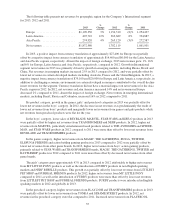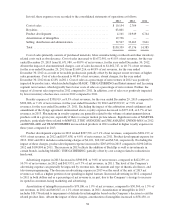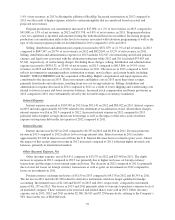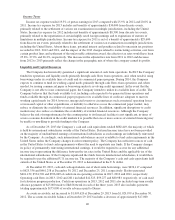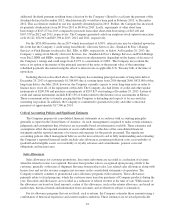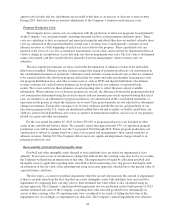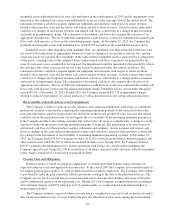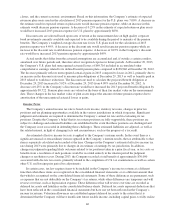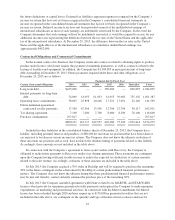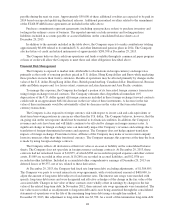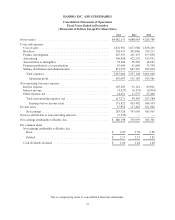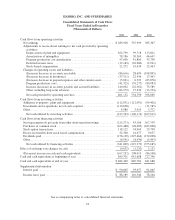Hasbro 2013 Annual Report Download - page 56
Download and view the complete annual report
Please find page 56 of the 2013 Hasbro annual report below. You can navigate through the pages in the report by either clicking on the pages listed below, or by using the keyword search tool below to find specific information within the annual report.
against actual results and any adjustments are recorded at that time as an increase or decrease to net revenues.
During 2013, there have been no material adjustments to the Company’s estimates made in prior years.
Program Production Costs
The Company incurs certain costs in connection with the production of television programs based primarily
on the Company’s toy and game brands, including animated and live-action programs and game shows. These
costs are capitalized as they are incurred and amortized using the individual-film-forecast method, whereby these
costs are amortized in the proportion that the current year’s revenues bear to management’s estimate of total
ultimate revenues as of the beginning of each fiscal year related to the program. These capitalized costs are
reported at the lower of cost, less accumulated amortization, or fair value, and reviewed for impairment when an
event or change in circumstances occurs that indicates that an impairment may exist. The fair value is determined
using a discounted cash flow model which is primarily based on management’s future revenue and cost
estimates.
The most significant estimates are those used in the determination of ultimate revenue in the individual-
film-forecast method. Ultimate revenue estimates impact the timing of program production cost amortization in
the consolidated statements of operations. Ultimate revenue includes revenue from all sources that are estimated
to be earned related to the television program and include toy, game and other merchandise licensing fees; first
run program distribution fees; and other revenue sources, such as DVD and digital distribution. Our ultimate
revenue estimates for each television program are developed based on our estimates of expected future
results. We review and revise these estimates at each reporting date to reflect the most current available
information. When estimates for a television program are revised, the difference between the program production
cost amortization determined using the revised estimate and any amounts previously expensed during that fiscal
year, are included as an adjustment to program production cost amortization in the consolidated statements of
operations in the quarter in which the estimates are revised. Prior period amounts are not adjusted for subsequent
changes in estimates. Factors that can impact our revenue estimates include the success and popularity of our
television programs in the U.S. which are distributed on Hub Network and available on Netflix and iTunes, our
ability to achieve broad distribution and viewer acceptance in international markets, and success of our program-
related toy, game and other merchandise.
For the year ended December 29, 2013 we have $79,965 of program production costs included in other
assets in the consolidated balance sheets. We currently expect that approximately 93% of capitalized program
production costs will be amortized over the 3-year period 2014 through 2016. Future program production cost
amortization is subject to change based on actual costs incurred and management’s then current estimates of
ultimate revenues. During 2013 the Company did not incur any significant impairment charges related to its
program production costs.
Recoverability of Goodwill and Intangible Assets
Goodwill and other intangible assets deemed to have indefinite lives are tested for impairment at least
annually. If an event occurs or circumstances change that indicate that the carrying value may not be recoverable,
the Company will perform an interim test at that time. The impairment test begins by allocating goodwill and
intangible assets to applicable reporting units. Goodwill is then tested using a two step process that begins with
an estimation of the fair value of the reporting unit using an income approach, which looks to the present value of
expected future cash flows.
The first step is a screen for potential impairment while the second step measures the amount of impairment
if there is an indication from the first step that one exists. Intangible assets with indefinite lives are tested for
impairment by comparing their carrying value to their estimated fair value which is also calculated using an
income approach. The Company’s annual goodwill impairment test was performed in the fourth quarter of 2013
and the estimated fair value of the Company’s reporting units with allocated goodwill were substantially in
excess of their carrying value. No reporting units were considered to be at risk of failing the first step of the
impairment test. Accordingly, no impairment was indicated. The Company’s annual impairment tests related to
44



